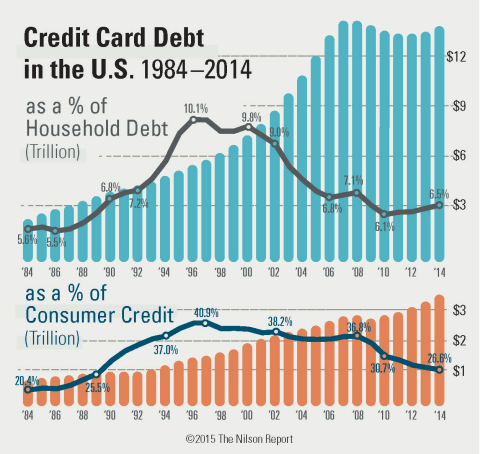CARPINTERIA, Calif.--(BUSINESS WIRE)--Total household debt in the U.S. was $13.512 trillion at the end of 2014 and credit cards accounted for 6.52% or $881.57 billion, according to the annual report on credit card debt in the U.S. published by The Nilson Report, the top trade newsletter covering the card and mobile payment industries. The ratio of credit card debt to household debt was highest in 1996 at 10.05%.
Card debt is comprised of outstanding receivables tied to general purpose and private label credit accounts. Debt on credit cards is a subset of total consumer credit, which was $3.317 trillion at the end of 2014. Total consumer credit is reported in the Federal Reserve Statistical Release, Z.1, Financial Accounts of the United States, Flow of Funds, Balance Sheets, and Integrated Macroeconomic Accounts, Table D.3, Credit Market Debt Outstanding by Sector. Card debt is compiled by The Nilson Report from its surveys of financial institutions and other credit card lenders.
Credit card debt accounted for 26.58% of total consumer credit at the end of 2014. "This is the lowest level of card debt to total consumer credit since 1990, when it was 29.42%," said David Robertson, publisher of The Nilson Report. "Card debt was highest in 1997, when it was 40.95% of consumer credit."
Total consumer credit is comprised of installment and non-installment unsecured personal loans, both closed and open-ended. The Federal Reserve does not count mortgage debt and low-value bank loans as consumer credit. However, total household debt includes consumer credit added to mortgage debt and low-value bank loans.
Mortgage debt (and select other loans) of $10.195 trillion in 2014 increased by $123.30 billion in 2014. Credit card debt increased by $38.23 billion, while total consumer credit grew by $218.40 billion.
Total U.S. household debt of $13.512 trillion in 2014 was up $341.70 billion from $13.170 trillion at year-end 2013. The average debt for each of the 123.2 million U.S. households at year-end 2014 was $109,650. One year before the average household debt was $107,549.
Consumer credit equaled 24.55% of household debt at the end of 2014, up from 23.53% the prior year. Consumer credit per household was $26,919. Not counted by the Federal Reserve as consumer credit are rent payments and automobile leases.
Credit card debt per household was $7,154 at year-end 2014, up from $6,887 in 2013.
About the Nilson Report
The Nilson Report is a highly respected source of global news and analysis of the card and mobile payment industries. The subscription newsletter provides rankings and statistics on the current status of the industry, as well as company, personnel, and product updates. David Robertson, Publisher of The Nilson Report and a recognized expert in the field, is a frequent speaker at industry conferences and is regularly quoted in publications worldwide. Over 18,000 readers in 90 countries value The Nilson Report.
This report is found in Issue 1,065, published June 16, 2015. Contact Lori Fulmer at lfulmer@nilsonreport.com for a complete copy of this newsletter.




